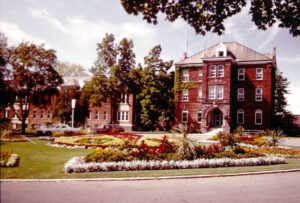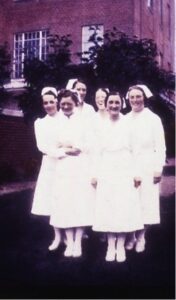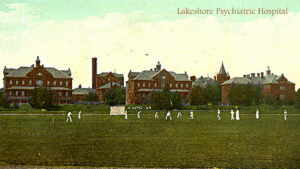Lakeshore Psychiatric Hospital
Name(s) of Institution:
Mimico Branch Asylum (1889)
Mimico Insane Asylum (1894)
Mimico Hospital for the Insane (1911)
Ontario Hospital, Mimico (1920)
Ontario Hospital, New Toronto (1934)
Lakeshore Psychiatric Hospital (1964–1979)
Opened:
1890 (as an adjunct to the Provincial Lunatic Asylum in Toronto) – closed in 1979.
Location:
3131 Lakeshore Boulevard West, Toronto, Ontario (1979 address)
Period of Deinstitutionalization:
1964-1979
Patient Demographic:
| YEAR | TOTAL | YEAR | TOTAL | YEAR | TOTAL |
| 1888 | 10 | 1950 | 1,391 | 1966 | 791 |
| 1890 | 116 | 1960 | 1,096 | 1967 | 632 |
| 1900 | 600* | 1961 | 1,101 | 1968 | 548** |
| 1910 | 602 | 1962 | 1,096 | 1969 | 532 |
| 1920 | 619 | 1963 | 1,111 | 1970 | 545 |
| 1930 | 795 | 1964 | 1,002 | 1971 | 545 |
| 1940 | 1,348 | 1965 | 829 | 1972 | 545 |
** Approximation. *** Patient load reduced to rated bed capacity in February.
Deinstitutionalization:

Construction began in 1881 and the Mimico Lunatic Asylum opened on January 20, 1890, at what was then considered the western part of the village of Mimico. This area eventually developed into an industrial centre called New Toronto in the 1890s. The region became incorporated by the city of Etobicoke in 1967 and merged with the City of Toronto in 1998. During its first four years of operation, the new mental health facility operated as an annex of the Asylum for the Insane, Toronto, 5.5 kilometres away. Hoping to deal with the overcrowding at 999 Queen Street, provincial superintendents met and designated the new site as for the care of patients deemed “incurably ill.” The hospital was built using, largely, patient labour (which was unpaid) under the philosophy of Dr. Joseph Workman, who believed in work as therapy. Kivas Tully, chief provincial architect and designer of several Ontario asylums, designed the buildings on the “cottage system,”deemed by some as superior for the classification and separation of patients, in contrast to the creation of one large central building, as was common during the period.
The hospital became independent in 1894 with a full-time staff. Lakeshore retained its independent status until it was closed in 1979.
Following the Second World War, several hospitals across Ontario were rebuilt or renovated. However, there were few moves toward modernization at Lakeshore, despite its having a higher patient load than the other Ontario hospitals. This trend continued until the late 1950s, when Dr. H. C. Moorehouse was appointed Superintendent. He spent his tenure revitalizing the institution. Dr. Moorehouse introduced outpatient and daytime care services at Lakeshore and reorganized the hospital into a unit system in which units provided patients concentrated care and treatment.
Dr. Donald Ross Gunn created a “Five Year Program” in 1971 with the goal of further modernizing Lakeshore. Nevertheless, due in part to fiscal constraints, in the mid-1970s, the provincial government began to discuss the possibility of closing the hospital or altering its purpose. Considerable worry was expressed by local physicians, including Dr. Jim Mackay of nearby Queensway Hospital, who stated that Lakeshore was Queensway’s “saviour” and the only hospital that would take violent psychiatric patients.
The 1978 McKinney Report provided a thorough report of psychiatric care and aftercare in Toronto, including at Lakeshore. In response to the reports of its substandard facilities, and as part of a larger shift from residential to community-based mental health, the facility was to be closed in 1979.This decision became a controversy throughout southern Ontario, and by early April of 1979, a meeting was convened between Metro Chairman Paul Godfrey, Etobicoke Mayor Dennis Flynn, Toronto Mayor John Sewell, and Ontario Premier William Davis to discuss the implications of Lakeshore’s closing. Meanwhile, the staff of the facility actively opposed the hospital’s downsizing, even attempting to prevent the transfer of thirty elderly patients to Queen Street Mental Health Centre. Eventually, police were brought in to allow a bus and two ambulances to carry the patients through one hundred picketers and out of Lakeshore to Queen Street (Toronto Star, January 23 and April 5, 1979). Ultimately, the recommendations of the McKinney Report were upheld, and throughout 1979, 280 patients were moved, with the vast majority being sent to Queen Street Mental Health Centre. By the end of 1979, the hospital was closed.
Transinstitutionalization:
In 1933, a service was established at Mimico to make clinic staff familiar with the community. It included a traveling clinic with a psychiatrist, a psychologist, and a social worker on staff. The clinic, like others across the province, was closed during the Second World War.
The 1952 Report of the Ontario Health Survey Committee recommended that the province establish and maintain mental health clinics for outpatients. The Committee stated that this expansion of services would “do more for the mental health of the province than any other single project.” This policy coincided with an interest in comprehensive community health care promoted by the federal government.
With the passing of the 1954 Mental Health Act, the province began developing and expanding community services. Subsequently, in 1955, a Director of Community Health Services was appointed to the central office of the provincial Mental Health Branch.
In 1959, a comprehensive outpatient service was established at New Toronto. Part of a provincial network of programs intended to provide early treatment for individuals showing signs of a psychotic disorder, a day care facility was established at New Toronto in 1959. The goal of the Day Care Centre was to provide more care than an outpatient clinic without the “disadvantages of complete hospitalization.” During the first year the Day Care Centre was in service, a patient’s median length of stay was less than twenty days. Although there were many readmissions, less than 9 percent of patients were recommended for transfer to mental hospitals.
After the closure of the hospital, outpatient and community services at Lakeshore provided patients with centralized and collaborative treatment through three community mental health centres: Lakeshore Area Multi-Service Project (LAMP), Peel Aftercare Resources (PAR), and Progress place.The institution also introduced Daycare, Assessment, and Rehabilitative Education (DARE) as a satellite program providing thorough industrial therapy, occupational therapy, and family and vocational counseling with staff on call around the clock.
In the 1980s, the Ministry of Health operated two outpatient programs in Cottages 1 and 2 at Lakeshore: an Industrial Therapy and Vocational Rehabilitation Program and a psychogeriatric clinic through PACE West. The Ministry of Community and Social Services also used the former hospital cottages to provide treatment, counseling, and skills training for at-risk youth and their families.
Work Therapy into Occupational Therapy:

Early institutional buildings at Lakeshore were constructed primarily by patients. The hospital acquired 220 acres of farmland. This property was extensively cultivated by patients and produced substantial quantities of vegetables. Then-Superintendent Dr. Beemer was a strong believer in meaningful work as rehabilitative therapy.
In 1958, patient labour on the farm was discontinued. In the 1960s, patients were encouraged to play sports and music, and a tennis court and gazebo were constructed for patient recreation.

In 1960, the provincial Department of Health established a Rehabilitation Branch to treat both current and former patients. The branch was to act as a consultative and advisory body to “both public and voluntary agencies in all phases of social and vocational rehabilitation.” Dr. Gunn, Director of Clinical Research at Lakeshore, reported that, “in order to make occupational therapy available to all patients, which should of course be the objective, each unit should have its own occupational therapy staff.”
Dr. Gunn was appointed Superintendent of Lakeshore in 1967. In February of that year, he opened a Child and Adolescent Unit which required patients with psychiatric and behavioural conditions to attend a school in the former superintendent’s residence.
Patient into Person:
Throughout the late 1950s, the idea of the mental hospital as a place that was open, rather than segregated into small units or separate and apart from the larger community, grew and took hold in Ontario. By 1958, an Open Door Program developed in the province, and by the end of the year, most mental hospitals were 40 percent open. These open doors represented not only freedom of movement between units of the hospital, but also between the institution and the community.
Recognizing the rights of former institutional residents to seek independence, the provincial Homes for Retarded Persons Act of 1966 and the Vocational Rehabilitation Services Act provided financial assistance to community residences to accommodate semi-independent living with moderate supervision.
Inspired by Dr. Moorehouse, a group of dedicated volunteers raised money to open a unique building and program at Lakeshore. Independent of the hospital and run by volunteers, The Moorehouse opened in 1969 and offered drinks, games, television, and a library, as well as other entertainment options for hospital patients. The Moorehouse also provided a noninstitutional space for visiting families.
Staffing in the Deinstitutionalization Era:

As with other Ontario institutions, a desperate staff shortage began during the 1930s and continued through the end of the Second World War. Though a travelling clinic with a psychiatrist, psychologist, and social worker were on staff had been established in 1933, this program was cancelled in 1938 due primarily to staff shortages.
In 1940, the staff-to-patient ratio was 296 staff to 1348 patients. By 1960, this had decreased significantly to 514 staff to 1096 patients. By 1970, the ratio was 729 staff to 545 patients, and by the time the hospital closed in 1979, the ratio was 675 staff to 280 patients.
In 1960, Director of Clinical Research Dr. Gunn reported that the current staffing requirement of one psychologist per unit was entirely inadequate for any intensive therapy, arguing that the minimum staffing component should include a director with a Ph.D. in psychology and three psychologists or more per unit.
Sources:
Barc, Agatha. Asylum by the Lake. https://www.asylumbythelake.com.
City of Toronto. “The Assembly Hall, A Lakeshore Landmark: 1898–2013.” City of Toronto. https://www1.toronto.ca/City%20Of%20Toronto/Economic%20Development%20&%20Culture/Cultural%20Services/Art%20Services/ART/Cultural%20Centres%20&%20Art%20Galleries/Assembly%20Hall/Assembly%20Hall%20History.pdf.
Gunn, Donald Ross. “Five Year Program.” Etobicoke: Lakeshore Psychiatric Hospital, 1971.
Gunn, Donald Ross. “Hospital Units.” Letter to Dr. Moorhouse, 5 August 1960. CAMH Archives.
Lakeshore Psychiatric Hospital Mimico, File 741. “A History of the Ontario Hospital, New Toronto, Henceforth to be Known as Lakeshore Psychiatric Hospital.” Target. Transcribed copy. 1961. CAMH Archives.
Melamet-Vetter, Walther. “The Lakeshore Psychiatric Hospital: A World in its Own, Another Coocoo’s Nest in New Toronto.” 1989. Lakeshore Psychiatric Hospital Fonds, File 2-12. CAMH Archives.
Ontario Department of Health. Ontario Department of Health Annual Reports–Mental Health Division. Toronto: Archives of Ontario.
Otto, Stephen A. “TULLY, KIVAS.” In Dictionary of Canadian Biography vol. 13. University of Toronto/Université Laval, 2003. https://www.biographi.ca/en/bio/tully_kivas_13E.html.
Peter Barnard Associates, with A.J. Diamond Planners Ltd. Lakeshore Planning Study, Final Report: Future Use Options for the Lakeshore Psychiatric Hospital Property. Toronto: Ministry of Government Services, 1986.
Pollock, Sheila Joy. “Social Policy for Mental Health in Ontario, 1930–1967.” PhD dissertation, University of Toronto, 1974.
Roberts, C.A. A Report on Ontario Mental Health Services. 1963. CAMH Archives.
Williston, Walter B. “Present Arrangements for the Care and Supervision of Mentally Retarded Persons in Ontario: A Report to the Honourable B.R, Lawrence, Minister of Health.” Ontario Department of Health, 1971. CAMH Library.


